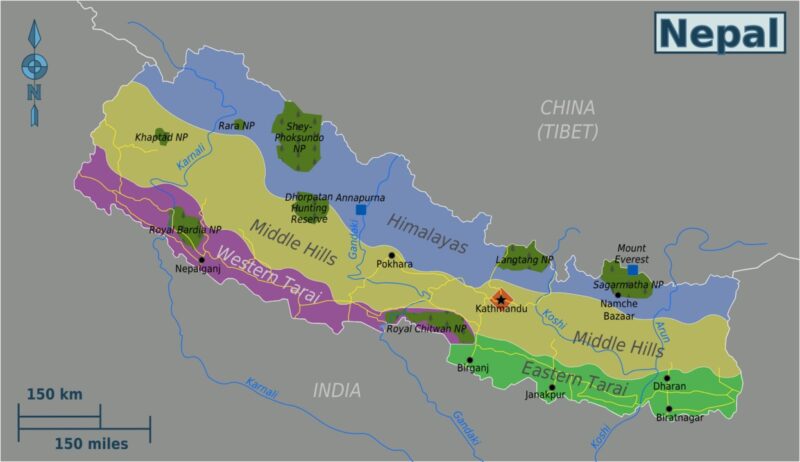About Nepal
Nepal is located in the heart of south-central Asia. It is a landlocked country dominated by the lofty peaks of the high Himalaya to the north that gradually give way to the low-lying plains of the Terai to the south. It is located 28.3949° N and 84.1240° E and is bordered on the east, south, and west by India, and on the north by the Tibet Autonomous Region of China. Its domain stretches from east to west for about 800 kilometers and from north to south for 230 kilometers wide.

The population of Nepal is 29.1 million. It has 8 climate zones ranging from tropical towards its Southern belt to perennial snow in the High Himalayas. As the seasons varies between these climate zones, whole of Nepal experiences a wet monsoon season from June to September barring a few areas of trans-Himalayan plateau to the North. Early fall and spring is often considered the best time to visit Nepal due to mild temperature, low rain and clear skies. Expeditions are generally conducted in the spring and fall.
Nepal has some of the world’s most rugged and severe alpine terrain. Mountains cover over 75 percent of the country. A complicated system of mountain ranges that spans 50 miles and ranges in elevation from 8,000 to 14,000 feet spans the country in its Northern side. The loftier mountains of the Inner Himalaya (Lesser Himalaya) rise to perennially snow-covered summits, which encloses the valley of Kathmandu. Some of Kathmandu’s important cities like Kathmandu and Pokhara are valleys surrounded by hills and mountains on all sides.
Nepal’s tourism sector generated Rs327.9 billion ($2.5 billion) and supported 1.19 million jobs, both directly and indirectly, in 2023. The jobs generated by the tourism sector is 15.2 percent of the total employment according to the World Travel and Tourism Council’s annual report.
Home to eight of the ten highest mountains in the world, Nepal is a destination for mountaineers, rock climbers and adventure seekers. The Great Himalaya Range, ranging in elevation from 14,000 to more than 29,000 feet, contains many of the world’s highest peaks—Everest, Kānchenjunga I, Lhotse I, Makālu I, Cho Oyu, Dhaulāgiri I, Manāslu I, and Annapūrna I—all of them above 26,400 feet.
Besides mountaineers, Nepal also attracts trekkers, casual visitors and cultural pilgrims throughout the year due to the diverse experience it offers. Diverse religious heritages of Nepal such as Hinduism and Buddihsm, its cool weather and hospitality are also strong attractions.
Some of the most popular destinations in Nepal include Mount Everest and the other 8000ers, traditional leisure destinations like Pokhara and Chitwan, the famous Annapurna Base Camp trail, Mardi and Manaslu treks. New destinations are cropping up throughout the country while new peaks are constantly added to its list of permissible peaks to climb. Recently, the Nepal government has opened an additional 97 peaks for climbing for free.